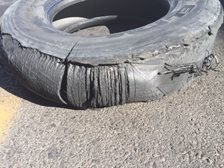Awhile back I wrote a blog about the numbers and letters on the sidewall of every tire. All these characters have a reason and purpose for being on the tire. Let's recap, the tire size is written in a metric, percent and inch format. We will use a single steer tire for our example tire, 275/80 R 22.5. The 275 is the tread width, 275 millimeters. 80 is the percent of tread width that equals the sidewall height, the sidewall would be 220 millimeters tall. R means the tire is of radial construction and of course the 22.5 is the wheel size in inches, 22.5 inches in diameter.
There is a DOT number on every tire, it is the serial number of the tire and date of manufacture. On our tire, it looks like this "DOT M5EJ O14X 1816". 1816 means the tire was built in the 18th week of 2016.
Another set of letters one should note is the load range, ours is LRH. This is the ply rating, ply ratings are counted by two's, 2, 4, 6, etc, and displayed on the tire in letters A-L excepting I, A=2, L=20. The  difference between the load capacities of a tire the same size with "G" vs "H" ratings. G 6175 lb @ 110 psi, H 6610 lb @ 120 psi, less than 500 lbs but could save you from getting a citation. The tire will also have recommended pressures for the load carried. Ours displays "MAX. LOAD SINGLE 3250 kg (7160 lbs) at 830 kPa (120 psi) COLD". In theory, one could expect to carry 14,320 lbs per axle in a single tire configuration. I'm not sure why but the max load is reduced for dual configurations, 6610 lbs @120 psi, in theory, that's 26,440 lbs per axle with duals, but that does exceed the 20,000 lb limit per axle, so I guess one would be safe.
difference between the load capacities of a tire the same size with "G" vs "H" ratings. G 6175 lb @ 110 psi, H 6610 lb @ 120 psi, less than 500 lbs but could save you from getting a citation. The tire will also have recommended pressures for the load carried. Ours displays "MAX. LOAD SINGLE 3250 kg (7160 lbs) at 830 kPa (120 psi) COLD". In theory, one could expect to carry 14,320 lbs per axle in a single tire configuration. I'm not sure why but the max load is reduced for dual configurations, 6610 lbs @120 psi, in theory, that's 26,440 lbs per axle with duals, but that does exceed the 20,000 lb limit per axle, so I guess one would be safe.
There is one more impression on the tire I would like to address, it's in a small oval molded on one side of the tire. It looks similar to "149/146 L AT 120 PSI", the first number is the load index 149=7160 lbs for a single tire. The second number is for duals 146=6610 lbs. The letter "L" in this case is the speed rating, L=75 mph. Most truck tires sold in North America have this limit, which brings me to my point of this blog.
I have been hearing of many trucks, usually, with a custom sleeper, that runs a 13 or 14,000 lb steer axle and larger tires to legally handle that weight, are having steer tire blowouts. For no apparent reason, they lose a steer tire and, in some cases, have crashed. During a conversation with a friend, we were discussing what we thought could be the cause. We, of course, have no studies or verifiable facts to confirm our suspicions but we know several of the drivers and how they drive. Very safe drivers in all cases we know of, well-maintained trucks, all running heavy axles and larger tires on the steer axle.
We all know how centrifugal force works, the faster something spins the larger (in the case of a tire) wants to grow to. Watch a Top Fuel Dragster do a burnout for a visual on this phenomenon. I do wonder if these blowouts could be prevented just by slowing down, as I mentioned above most tires sold in North America have a speed rating of 75 mph. Does mean you should run that speed all the time? I don't think so. Run up there for a short period (where it's legal) for passing then slow to a more reasonable speed. I know the speed limit is above 75 in several states but it is a maximum, not a required minimum. The NHTSA (National Highway Transportation Safety Administration) investigated 16 crashes all caused by steer tire blowouts in one fleet. They determined all 16 failures were most likely due to exceeding the 75-mph rating.
Drive where you feel comfortable and safe and maintain your tire pressures. These speed ratings are for the pressures on the sidewall, 120 psi in most cases. One article I read stated every 5 psi lower than max. inflation pressure lowers speed rating by about 5 mph.
If that is the case 110 psi will leave you with a 65-mph speed rating. When you speak to a tire engineer they will tell you to run the pressure for the load you are carrying. That would mean adjusting tire pressure for nearly every load, no one is going to do that. We run our tire pressures for the max load we will ever carry, not to exceed the sidewall pressures.
Whatever the cause of these steer axle blowouts, I believe one should consider all possibilities for the cause and adjust their operation so it won't happen to them or it won't happen again. I can't imagine how scary it would be to lose a steer tire at 75 mph or at any speed for that matter.